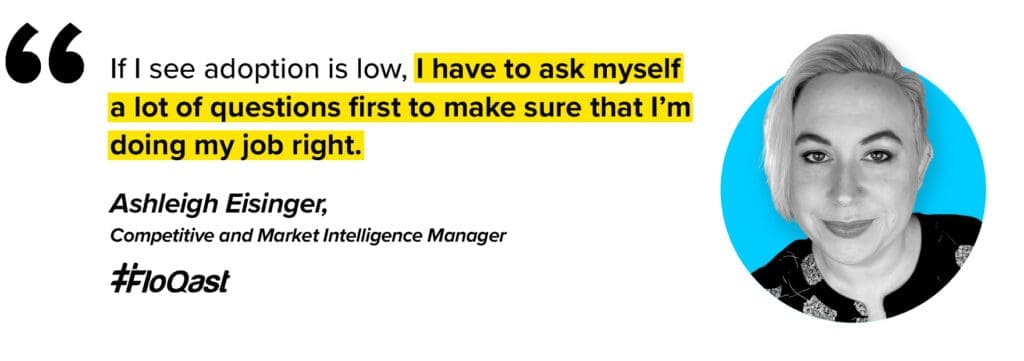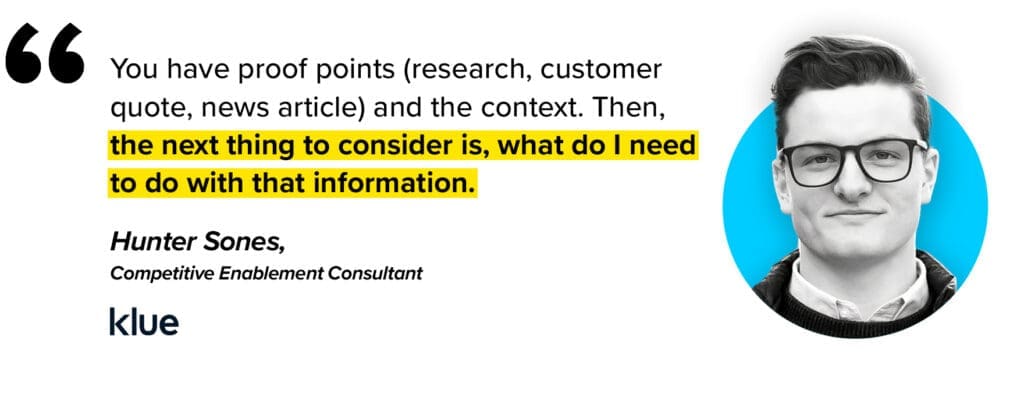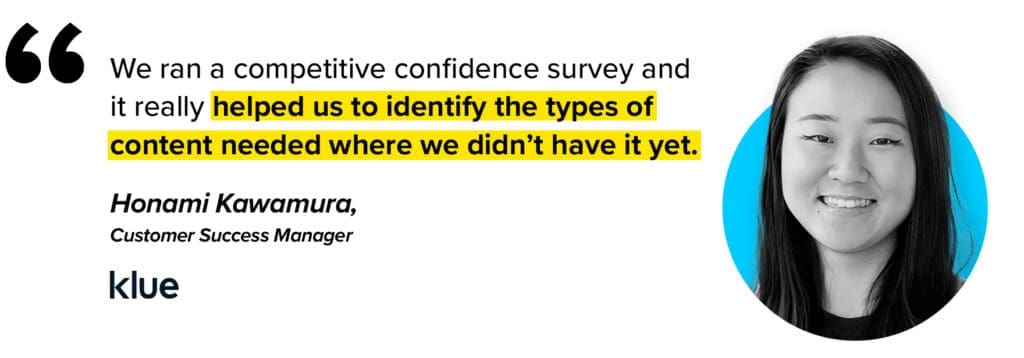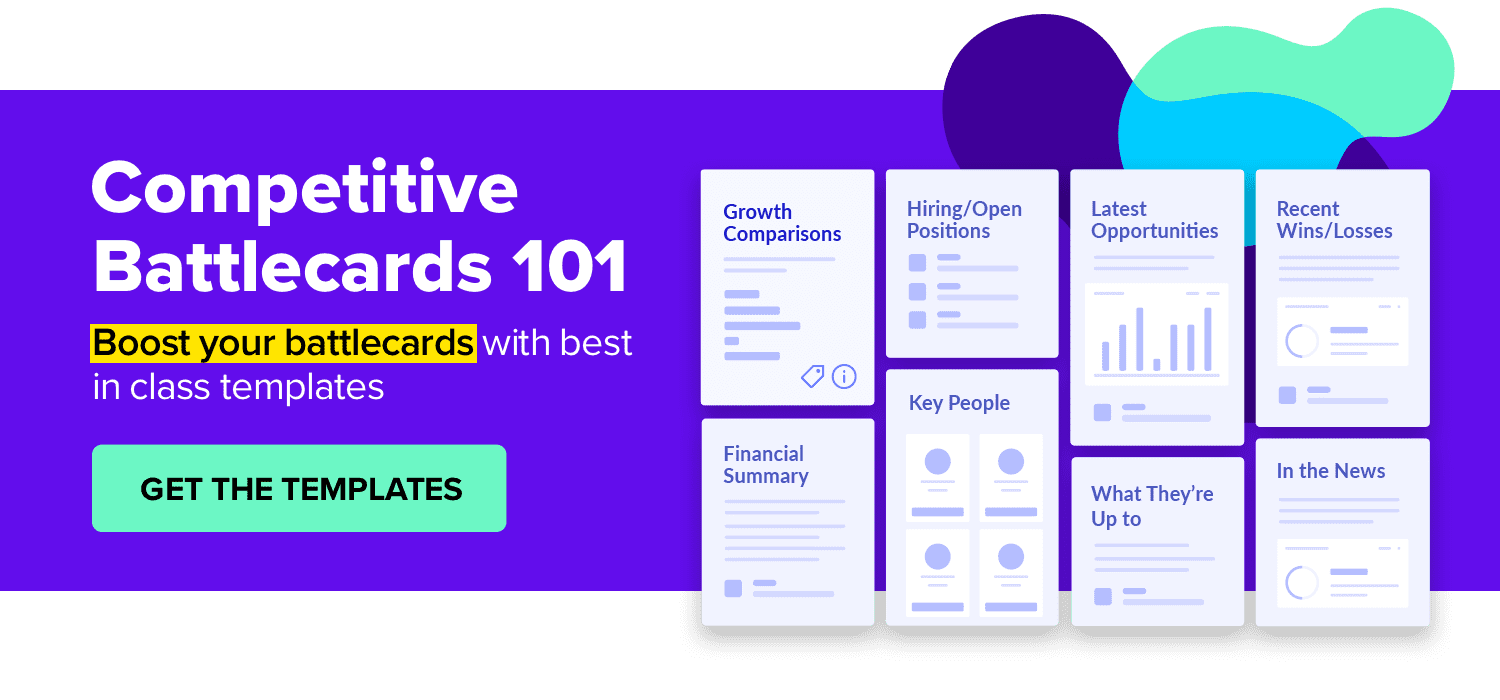Klue Compete
The Competitive Enablement Platform
Learn More
FIND OUT MORE >

You’ve got the competitive intelligence. You’re bought into competitive enablement. You’ve even built some killer battlecards.
There’s just one, very big, problem — no one’s using them.
What’s the reason for low adoption? Well, there’s never just one reason, nor is there one quick and easy solution.
But talk to the experts and you’ll quickly find that there are tried and true methods of boosting adoption.
Here are four ways you can increase adoption of your competitive enablement content.


One sure-fire way to increase adoption? Build Better Battlecards. Watch this video series and find out how.
More than just a convenient excuse for breaking off a relationship, the it’s not you, it’s me approach works for addressing low adoption too.
Using this approach, FloQast’s Competitive and Market Intelligence Manager Ashleigh Einsiger‘s first course of action to solving adoption is to turn inwards.
“If I see adoption is low, I have to ask myself a lot of questions first to make sure that I’m doing my job right.”
Four questions in fact.
Did you make enough noise in your competitive intel Slack/Teams channel? Did you clearly highlight the new content (and why it’s important) in your competitive intelligence newsletter? Have you followed up with people individually?
Did you tag the content properly in your competitive enablement platform? Is your intel organized in a logical way? Make sure content is easily accessible (ideally one click away), and categorized so your users don’t get lost trying to find it.


Does your content meet the needs of the intended audience, in a format that works for them? The same competitive intel could be valuable for a bunch of different teams. But how that intel is packaged and delivered needs to be done in a way that’s obviously relevant to them.
Even if your reps know about your content, can find it, and appreciate its relevance, if they don’t know how to use it, it won’t get adopted. Be prescriptive in how, why and when a particular piece of intel should be levered in a deal.
This is your cue to directly connect with your users — individual reps and leadership — to ask for feedback. Ashleigh’s approach:
“What’s missing? Why are you not interested in it? Get all that feedback back and you can make those changes appropriately.”
We dove deep and analyzed thousands of anonymous battlecards. We looked at battlecards that got used a lot, and the ones that didn’t.
Battlecards that don’t include prescriptive guidance on how a piece of intel is supposed to be used and why it’s relevant are far less likely to be used than does that do.
(Check out the entire data dive in our Klue: By the Numbers Series)


Put another way, Competitive Enablement Consultant Hunter Sones says that there are two pieces of information that all good battlecards should include:
“You have proof points (research, customer quote, news article) and the context. Then next thing is what do I need to do with that information”
If you’re in charge of competitive enablement, you’ve analyzed enough deals and gotten enough feedback from reps to know which competitive plays work best and at what time. So don’t be afraid to lead the horse to water.
Sales reps don’t always love being told what to do. But when your content starts helping them tip more winnable deals, they’re sure to start loving — and adopting — your content.
While 95% of battlecards contained enough context (know), less than half included talk tracks (say) and less than one-fifth contained supporting evidence
The best compete experts use a one-two punch for collecting feedback from their stakeholders.
Punch one: talk to people one-on-one (or in small groups) and get in-the-moment feedback. Punch two: send out a competitive confidence survey collect their answers.
Surveying your team’s confidence on factors like how confident they feel selling against your competitors, and how confident they are in your product’s position in the market gives you direction for how to better enable them.
But the best part of running a competitive confidence survey is that it gauges your team’s confidence in your competitive content.


Klue Customer Success Manager Honami Kawamura says running a confidence survey with a past customer made a world of difference.
“There was some turnover in their organization. They were seeing some low adoption rates. So we ran that survey and it really helped us to identify the type of content that folks need where we don’t have yet.”
Armed with feedback, you now have a clearer idea of where you should focus your efforts. And just by asking your end-users for their input, you’re building that all-important relationship.
If all those good things weren’t enough, measuring competitive confidence over time and comparing the results can turn into a compete metric and KPI you can take to the bank.


Highspot’s Jarrod Greene and CoachHub’s Anthony Fritsch make it their mission to build a “culture of compete” at their organizations.
A big part of doing so is creating an identity for your compete program. One that helps it standout with your stakeholders and make people want to be a part of it.
Nearly all the experts we talk to give the same piece of advice: make compete fun. CSM Manager Sophie Baker says there are a ton of creative ways clients have worked to make compete more fun and enjoyable.
“I’ve seen a lot of wild stuff when it comes to making compete fun. Batman themes. I’ve seen folks recreate the Klue board game, do scavenger hunts. It might sound kitschy — but it works!”
Another can’t-go-without element of a culture of compete is colleague shoutouts. Reps who are actively sharing intel and successfully leverage compete content deserve kudos. Make sure you’re acknowledging their contributions publicly in all your competitive enablement channels.
Imperva’s Pat Wall says building a culture of compete is not a sprint, it’s not even a marathon — it’s an ultra marathon.
But start putting in the work today, following these best practices, and you’ll make your next quarter the best quarter yet.
And don’t be surprised if you start seeing immediate results. These expert tips are just that good.




Competitive Enablement
The topic of Large Language Models (LLMs) has a lot of confusion. Here's what you need to know about how Klue is working with them.


Competitive Enablement
Product Marketing
If your competitive intel game is too strong for automation, too pure for data privacy, and too rebellious for accuracy — then Klue AI is probably not for you.


Let’s do it. Tell us a bit about yourself and we’ll set up a time to wow you.
Let's do it. Tell us a bit about yourself and we'll set up a time to wow you.
XLet's do it. Tell us a bit about yourself and we'll set up a time to wow you.
XSubscribe to get our latest AI functionality and news in your inbox.
XOur Buyer Pulse feature, set to launch in Q2 2024, offers valuable insights into the factors influencing buyer decisions in your pipeline. By signing up for the waitlist, we can better gauge interest and proactively engage with you to streamline the setup and integration process before the feature becomes widely available.
X